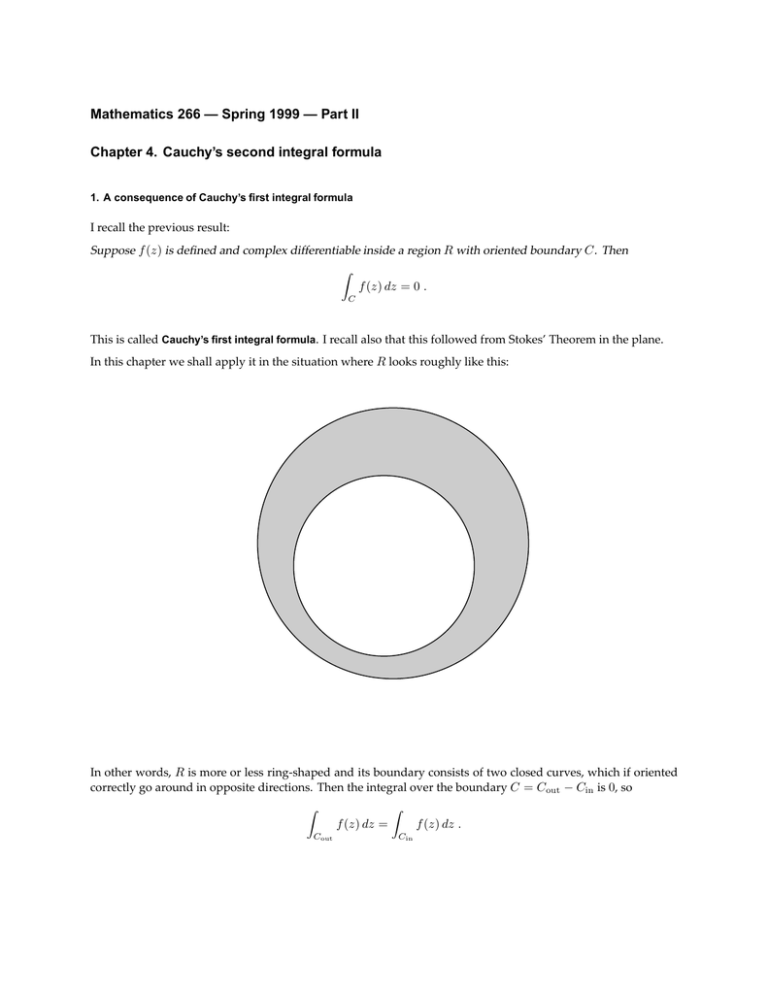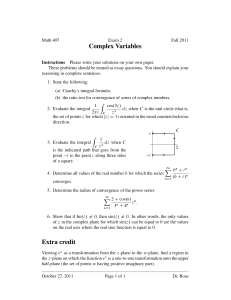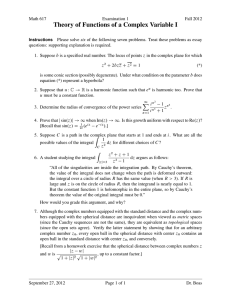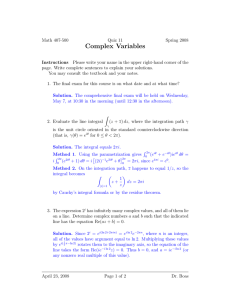Mathematics 266 — Spring 1999 — Part II
advertisement

Mathematics 266 — Spring 1999 — Part II Chapter 4. Cauchy’s second integral formula 1. A consequence of Cauchy’s first integral formula I recall the previous result: Suppose f (z) is defined and complex differentiable inside a region R with oriented boundary C . Then Z C f (z) dz = 0 . This is called Cauchy’s first integral formula. I recall also that this followed from Stokes’ Theorem in the plane. In this chapter we shall apply it in the situation where R looks roughly like this: In other words, R is more or less ring-shaped and its boundary consists of two closed curves, which if oriented correctly go around in opposite directions. Then the integral over the boundary C = Cout − Cin is 0, so Z Z Cout f (z) dz = Cin f (z) dz . Cauchy’s second integral formula 2 2. Cauchy’s second formula Suppose f (z) is complex differentiable in a region R with a simple closed boundary C . That is to say that C has just a single piece, and doesn’t wrap around and cross over itself. Cauchy’s second integral formula asserts that if z0 is any point in the inside of R then Z C f (z) dz = 2πif (z0 ) . z − z0 Be sure you realize that z here is the integration variable which travels around C , and that z0 is fixed inside the integral. This may seem like a rather formal result, but it is very important, with many consequences. We shall of course only sketch roughly why it is true, but even this will take a while. 3. First step Draw a little circle Cr of radius r around z0 , which is small enough to be contained in R. Then the function f (z) z − z0 is defined and complex differentiable inside R and outside Cr . Therefore, from Cauchy’s first formula Z C f (z) dz = z − z0 Z Cr f (z) dz z − z0 so we may as well assume that R is the inside of the circle Cr . 4. Second step Suppose that f (z) is a constant function, say c. Thus we want to see that Z |z−z0 |=r c dz = 2πic . z − z0 We may as well assume that c = 1. But then we can parametrize the curve |z − z 0 | = r by t 7→ z(t) = z0 + (r cos t + i sin t) which makes the integral Z 0 2π Z 1 2π 1 (−r sin t + ir cos t) dt = 2 (−r sin t + ir cos t)(r cos t − ir sin t) dt r cos t + ir sin t r 0 Z 2π (− sin t + i cos t)(cos t − i sin t) dt = 0 Z = 2π 0 = 2πi (We have seen this calculation before, in a special case.) (− sin t cos t + sin t cos t) + i(cos2 t + sin2 t) dt Cauchy’s second integral formula 3 5. Third step Z Consider |z−z0 |=r f (z) − f (z0 ) dz . z − z0 We claim that this is 0. This is because of the following useful technical lemma: Z f (z) dz ≤ M L We have an estimate C if |f (z)| ≤ M on C and L is the length of C . This Lemma follows easily from the definition of the complex integral and this simple triangle inequality: |w + z| ≤ |w| + |z| for all complex numbers w and z . Why does the lemma imply the result we want? The integral is independent of r, as we already know. The function f (z) − f(z0 ) is approximately f 0 (z0 )(z − z0 ) for z near z0 , hence by taking r very small. But this implies immediately that for r small enough, (f (z) − f (z0 ))/(z − z0 ) will be bounded by some fixed constant M . But then by the Lemma Z f (z) − f (z0 ) dz =≤ 2πrM |z−z0 |=r z − z0 is also arbitrarily small, hence 0. 6. The last step Now put all these cases together. We have Z C f (z) dz z − z0 Z = Cr Z = Cr f (z) dz z − z0 Z f (z) − f (z0 ) f (z0 ) dz + dz z − z0 z − z0 Cr = 0 + 2πif (z0 ) by the previous step. We are done. We can also write Cauchy’s second formula as 1 f (z0 ) = 2πi Z C f (z) dz . z − z0 Exercise 6.1. Suppose that C is a simple closed curve in the plane (does not cross itself, and is closed). Calculate 1 2πi Z C 1 dz z−α under the assumptions (1) α lies inside C and (2) it lies outside C . Cauchy’s second integral formula 4 Exercise 6.2. Suppose P (z) = (z − z1 )(z − z2 ) . . . (z − zn ) with all the zi different. Suppose the first k of the roots zi lie inside C and the rest outside it. Find a formula for Z P 0 (z) dz C P (z) Hint: Try the cases n = 1 and n = 2 first. First calculate P 0 (z) explicitly and then find a simple expression for for P 0 (z)/P (z). For example if P (z) = (z − a)(z − b) we can write (by the product rule) P 0 (z) = (z − a) + (z − b), and P 0 (z)/P (z) = 1/(z − a) + 1/(z − b) . Z Exercise 6.3. Find a formula for 1 dz 2+1 z C where C is the path going from −R to R, then around the arc going from R to −R in the complex plane, counter-clockwise, with R > 1. (Hint: Write z2 A B 1 = + +1 z−i z+i for suitable constants A and B .) 7. An efficient way to do it The sort of calculation involved in applying Cauchy’s Second Integral Formula will get nastier and nastier if we attempt it directly. So it will be better if we explain some general consequences of Cauchy’s Theorems. A function f (z) is said to have at most a simple singularity at z = z0 if it can be written as F (z) z − z0 F (z) is defined and complex differentiable at z0 . Cauchy’s Second Theorem then tells us how to evaluate Z f (z) dz C if f (z) has no singularities inside C except at z0 , and at z0 it has a simple singularity. Namely, we set F (z) = (z − z0 )f (z), which by definition has no singularities at all inside C , and obtain Z C f (z) dz = 2πiF (z0 ) . The number F (z0 ) is called the residue of f at z0 . This can be extended to apply in somewhat more general circumstances. First of all, suppose C to be a curve with positive orientation. Suppose f (z) has possibly several simple singularities inside C , say at z1 , z2 , . . . , zn . Then Z C f (z) = 2πi(R1 + R2 + · · · + Rn ) where Ri is the residue of f at zi . We can see this by setting Z Z C f (z) dz = C1 f (z) dz + · · · + Z Cn f (z) dz where each of the Ci just contains the single singularity zi . So we need to know a practical way to compute the residue of f (z) at a singularity. We can do this directly, but it can by very painful. Here is a trick which we can often apply. Cauchy’s second integral formula 5 • Suppose f (z) = P (z) Q(z) where P (z) is complex differentiable at z0 and Q has a simple zero at the point z0 . Then the residue of f (z) at z0 is equal to P (z0 ) Q0 (z0 ) What the assumption about Q means is that we can write Q(z) as the product of (z − z0 )R(z) where R(z) is a complex differentiable function with R(z 0 ) 6= 0. Then by definition, the residue of f at z 0 is equal to P (z0 )/R(z0 ). But we also have Q(z) = (z − z0 )R(z) Q0 (z) = R(z) + (z − z0 )R0 (z) Q0 (z0 ) = R(z0 ) We shall see soon many examples of how to use this. Exercise 7.1. Find a formula for Z C e−iaz dz z 2 + b2 where a, b > 0 and C is the path going from −R to R, then around the arc going from R to −R in the complex plane clockwise with R > b. Then do a similar calculation for a < 0. (One possible hint: Write z2 B A 1 + = 2 +b z − ib z + ib for suitable constants A and B .) Z Exercise 7.2. Find a formula for C z4 1 dz +1 where C is the path going from −R to R, then around the arc going from R to −R in the complex plane, counter-clockwise, with R > 1. (Hint: split C in two halves.) Exercise 7.3. Find a formula for Z C z2 + z + 1 dz z2 − 1 where C is the counter-clockwise circle of radius R with R > 1. (One possible hint: Write A B 1 = + z2 − 1 z−1 z+1 for suitable constants A and B .) 8. Higher derivatives We can formally differentiate Cauchy’s second formula with respect to z0 to get f 0 (z0 ) = 1 2πi f (n) (z0 ) = n! 2πi and if we keep on going we get Z C f (z) dz (z − z0 )2 C f (z) dz (z − z0 )n+1 Z Cauchy’s second integral formula 6 It is not hard to infer that not only f (z) but also all of its derivatives are complex differentiable. There is an interesting relationship with Fourier series. If we choose C to be the circle of radius r around z0 and parametrize it as z(t) = z0 + r(cos t + i sin t), then the integral becomes 1 f (n) (z0 ) = n! 2πrn Z 2π F (t)e−int dt, 0 F (t) = f (z(t)) . In other words, the n-th derivative of f (z) at z0 is some simple scalar times a Fourier coefficient of the restriction of f (z) to the circle C , considered as a function of angle with period 2π . We shall more of this idea later on. Exercise 8.1. Let f (z) = 1/(1 + z). Restrict it to the unit circle kzk = r with r < 1. Find its complete Fourier series as a function of angle. (Hint: think ‘geometric series’.) Exercise 8.2. Same question, but with r > 1. Exercise 8.3. Let f (z) = 1/(1 + z 2 ). Restrict it to the unit circle kzk = r with r < 1. Find its complete Fourier series as a function of angle. (Hint: think ‘geometric series’.) Exercise 8.4. Same question, but with r > 1. Exercise 8.5. Let f (z) = 1/(1 + z + z 2 ). Restrict it to the circle kzk = r with r < 1. Find its complete Fourier series as a function of angle. (Hint: Factor 1 + z + z 2 . Rewrite the expression 1/(1 + z + z 2 ) as a sum of simpler fractions.) Exercise 8.6. Same question, with r > 1. 9. An application to real integrals The problem we look at here is that of evaluating the real integral Z ∞ −∞ This is the limit as R → ∞ of Z 1 dx . x2 + 1 R −R x2 1 dx . +1 + This in turn is a piece of the closed curve CR made up of two pieces in all: (1) the interval [−R, R]; (2) an arc CR running counter-clockwise from R to −R at radius R. So the real integral we are looking at is the difference of two complex integrals Z Z z2 CR 1 dz − +1 + CR z2 1 dz . +1 The first integral we can evaluate by Cauchy’s second formula. We can write it as Z CR 1 dz = 2 z +1 Z CR 1 1 dz = (z + i) (z − i) where F (z) = 1 , (z + i) z0 = i . Since CR is closed and z0 lies inside it, the integral is 2πiF (i) = Z 2πi =π. 2i CR F (z) 1 dz z − z0 Cauchy’s second integral formula 7 The second integral is not easy to evaluate at all, but it has this property: as R → ∞ it has limit 0. This follows from the same technical Lemma we used in Step (3) above. Using that lemma, we see that Z 1 2πR dz ≤ C + z 2 + 1 R2 − 1 R which becomes arbitrarily small as R gets large. The final result we get is that Z ∞ −∞ Exercise 9.1. Do the same to find Z 1 dx = π . x2 + 1 ∞ −∞ Exercise 9.2. Do the same to find Z ∞ −∞ eix dx . +1 x2 e−iax dx x2 + 1 with a < 0; a > 0. For these two cases you will have to choose different paths, one going into the lower half-plane instead of the upper one. Exercise 9.3. Do the same to find Z ∞ −∞ 1 dx . x4 + 1




